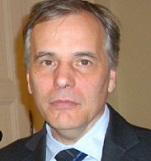

Plenary Lecture
Mathematical Modelling of Deterministic and Random Composites

Professor Vladimir Mityushev
Department of Computer Sciences and Computer Methods
Pedagogical University of Cracow
Poland
Email: mityu@up.krakow.pl
Abstract: The talk is devoted deterministic and random heterogeneous materials and to constructive analytical methods to compute their macroscopic properties. Randomness in such problems reveals through random tensor-functions locally describing the physical properties of medium. Despite the considerable progress made in the theory of disordered media, the main tool for studying such systems remains numerical simulations. Frequently, it is just asserted that it is impossible to get general analytical formulae for the effective properties except dilute composites when interactions among inclusions are neglected and except regular composites having simple geometric structures. This opinion sustained by unlimited belief in numerical computations have to be questioned by the recent pure mathematical investigations devoted to explicit solution to the Riemann-Hilbert problem for multiply connected domains and by significant progress in symbolic computations. These recent theoretical results can be effectively implemented in symbolic form that yields analytical formulae for random composites. In this talk, we restrict ourselves to two-phase conducting composites with non-overlapping inclusions. The proposed method leads to construction of the new RVE (representative volume element) theory for dispersed composites. The effective tensor can be written in the form of expansion in the moments of the correlation functions which can be considered as "basic elements" depending only on locations of inclusions. The RVE is defined as the minimal size periodicity cell corresponding to the set of basic elements calculated for the composite. A simple fast algorithm to determine the representative cell for a given composite is based on reduction of the number of inclusions per periodicity cell having the same basic elements as the given composite. The results are applied to random optimal packing and to computation of the corresponding critical exponent for superconducting inclusions. A criterion of stir casting processes is introduced. It is explained why the hexagonal pattern formation is frequently met in nature.
Brief Biography of the Speaker: Vladimir Mityushev graduated the Faculty of Mechanics and Mathematics at the Byelorussian State University of Minsk (Belarus) in 1980 and obtained PhD in Physics and Mathematics in 1984 at the same University. He has obtained the habilitation degree in Technology at Poznan Technological University (Poland) in 1997. His research fields includes: Mathematical modeling and computer simulations, Industrial mathematics, Boundary value problems, Riemann-Hilbert problem for multiply connected domains, Iterative functional equations, Elliptic PDE, Effective properties of composites with deterministic and random structure, Fiber composites, RVE, Porous media, Permeability and diffusion, Navier-Stokes equations in domains with complex geometry, Viscous flow in wavy channels, Elasticity, Thermoelasticity and Mechanics of fracture, Electroosmotic phenomena, Symbolic computations, Packing, Deterministic and random graphs. He published as author or co-author over 150 articles in journals. Vladimir Mityushev wrote and edited 11 books. He is Visiting research professor of Equipe Milieux Poreux et Fracturés Paris VI, France. He is a member of AMS and of ISAAC, Academician of Russian Academy of Informatization. http://mityu.up.